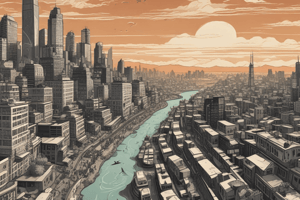Podcast
Questions and Answers
What was the primary setting for most Americans' daily lives until the 1920s?
What was the primary setting for most Americans' daily lives until the 1920s?
- Cities and towns
- Industrial areas and factories
- Farms and small towns (correct)
- Formal organizations and bureaucracies
What is a characteristic of a formal organization?
What is a characteristic of a formal organization?
- It is only found in small businesses and communities
- It is deliberately created to achieve one or more long-term goals (correct)
- It is typically informal and spontaneous
- It is based on emotions and personal relationships
What is the primary purpose of bureaucracies?
What is the primary purpose of bureaucracies?
- To promote individual creativity
- To create a sense of community among members
- To make decisions based on emotions
- To achieve efficiency and rationality (correct)
Where are bureaucracies commonly found?
Where are bureaucracies commonly found?
What is a characteristic of Americans' daily lives in industrialized societies?
What is a characteristic of Americans' daily lives in industrialized societies?
What is an example of a type of formal organization?
What is an example of a type of formal organization?
Where did most Americans spend their daily lives until the 1920s?
Where did most Americans spend their daily lives until the 1920s?
What was the dominant lifestyle for most Americans until the 1920s?
What was the dominant lifestyle for most Americans until the 1920s?
Where were most Americans' daily lives centered around until the 1920s?
Where were most Americans' daily lives centered around until the 1920s?
What characterized most Americans' daily lives until the 1920s?
What characterized most Americans' daily lives until the 1920s?
In what kind of setting did most Americans spend their daily lives until the 1920s?
In what kind of setting did most Americans spend their daily lives until the 1920s?
Study Notes
Societal Shift from Primary to Secondary Groups
- Until the 1920s, most Americans lived in rural areas and small towns, surrounded by primary groups like families, neighborhoods, and churches.
- With industrialization and urbanization, Americans' daily lives became more involved with secondary groups.
Formal Organizations
- A formal organization is a deliberately created entity to achieve long-term goals.
- Examples of formal organizations include:
- Educational institutions (high schools, colleges)
- Business entities (corporations, small businesses)
- Government agencies (local, state, federal)
- Medical groups (hospitals, physicians groups)
- Religious bodies (churches, synagogues, mosques)
- Political organizations (political parties, interest groups)
- Fraternal societies and social clubs
Bureaucracies
- A bureaucracy is a formal organization based on rationality and efficiency.
- Despite a reputation for inefficiency, bureaucracies have proven effective in industrial societies.
- Bureaucracies can be found in various sectors, including governments and corporations.
Before Industrialization and Urbanization
- Until the 1920s, most Americans lived on farms or in small towns and villages
- Daily lives were spent in primary groups, such as families, neighborhoods, and churches
Effects of Industrialization and Urbanization
- Americans became more involved in secondary groups
- Increased interaction with formal organizations, such as hospitals, schools, corporations, and government agencies
Characteristics of Formal Organizations
- Deliberately created to achieve one or more long-term goals
- Examples of formal organizations include:
- Educational institutions (high schools, colleges)
- Business entities (corporations, small businesses)
- Government agencies (local, state, federal)
- Medical groups (hospitals, physicians groups)
- Religious bodies (churches, synagogues, mosques)
- Political organizations (political parties, interest groups)
- Fraternal societies and social clubs
Bureaucracies
- Formal organizations based on rationality and efficiency
- Found in various sectors, including governments, corporations, and more
- Despite negative perceptions, bureaucracies have proven to be effective in industrial societies
Studying That Suits You
Use AI to generate personalized quizzes and flashcards to suit your learning preferences.
Description
This quiz explores the shift of Americans from rural to urban living, and the impact on primary and secondary groups. It covers the effects of industrialization and urbanization on daily life, from birth to death.




